Substance P inhibits GABAB receptor signalling in the ventral tegmental area
- PMID: 20231139
- PMCID: PMC2876808
- DOI: 10.1113/jphysiol.2010.188367
Substance P inhibits GABAB receptor signalling in the ventral tegmental area
Abstract
Substance P (SP) and its receptors are involved in anxiety-related behaviours and regulate the intake of drugs of abuse and alcohol. Within the midbrain ventral tegmental area (VTA), a region that is clearly involved in the control of these behaviours, SP is released by stress and has been shown to trigger relapse. SP activates neurokinin (NK) receptors, which excites midbrain dopamine (DA) neurons and leads to increased DA in target regions. In this study, we have investigated the mechanisms underlying SP actions in the VTA, specifically investigating interactions between SP and GABA(B) receptors. We show that in VTA neurons, NK receptor activation closes an inwardly rectifying potassium channel, and moreover inhibits GABA(B) receptor-mediated transmission through an interaction that depends upon phospholipase C (PLC), intracellular calcium and protein kinase C (PKC).
Figures
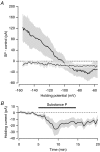

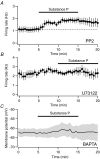
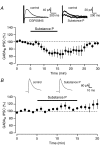
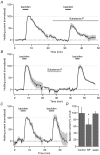

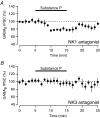
Similar articles
-
Dopamine inhibits GABA(A) currents in ventral tegmental area dopamine neurons via activation of presynaptic G-protein coupled inwardly-rectifying potassium channels.Neuroscience. 2010 Feb 17;165(4):1159-69. doi: 10.1016/j.neuroscience.2009.11.045. Epub 2009 Nov 26. Neuroscience. 2010. PMID: 19944748
-
Bi-directional effects of GABA(B) receptor agonists on the mesolimbic dopamine system.Nat Neurosci. 2004 Feb;7(2):153-9. doi: 10.1038/nn1181. Epub 2004 Jan 25. Nat Neurosci. 2004. PMID: 14745451
-
Tipepidine activates VTA dopamine neuron via inhibiting dopamine D₂ receptor-mediated inward rectifying K⁺ current.Neuroscience. 2013 Nov 12;252:24-34. doi: 10.1016/j.neuroscience.2013.07.044. Epub 2013 Jul 26. Neuroscience. 2013. PMID: 23896570
-
Differential involvement of ventral tegmental GABA(A) and GABA(B) receptors in the regulation of the nucleus accumbens dopamine response to stress.Brain Res. 2007 May 30;1150:62-8. doi: 10.1016/j.brainres.2007.02.081. Epub 2007 Mar 6. Brain Res. 2007. PMID: 17395162
-
GABA-A and GABA-B receptors mediate feeding elicited by the GABA-B agonist baclofen in the ventral tegmental area and nucleus accumbens shell in rats: reciprocal and regional interactions.Brain Res. 2010 Oct 8;1355:86-96. doi: 10.1016/j.brainres.2010.07.109. Epub 2010 Aug 7. Brain Res. 2010. PMID: 20696149
Cited by
-
Nicotine enhances excitability of medial habenular neurons via facilitation of neurokinin signaling.J Neurosci. 2014 Mar 19;34(12):4273-84. doi: 10.1523/JNEUROSCI.2736-13.2014. J Neurosci. 2014. PMID: 24647947 Free PMC article.
-
Evidence and explanation for the involvement of the nucleus accumbens in pain processing.Neural Regen Res. 2020 Apr;15(4):597-605. doi: 10.4103/1673-5374.266909. Neural Regen Res. 2020. PMID: 31638081 Free PMC article. Review.
-
Reversal of inhibition of putative dopaminergic neurons of the ventral tegmental area: interaction of GABA(B) and D2 receptors.Neuroscience. 2012 Dec 13;226:29-39. doi: 10.1016/j.neuroscience.2012.08.045. Epub 2012 Sep 15. Neuroscience. 2012. PMID: 22986166 Free PMC article.
-
Nucleus Accumbens Subnuclei Regulate Motivated Behavior via Direct Inhibition and Disinhibition of VTA Dopamine Subpopulations.Neuron. 2018 Jan 17;97(2):434-449.e4. doi: 10.1016/j.neuron.2017.12.022. Epub 2018 Jan 4. Neuron. 2018. PMID: 29307710 Free PMC article.
-
An atlas of transcriptionally defined cell populations in the rat ventral tegmental area.Cell Rep. 2022 Apr 5;39(1):110616. doi: 10.1016/j.celrep.2022.110616. Cell Rep. 2022. PMID: 35385745 Free PMC article.
References
-
- Bailey CP, Maubach KA, Jones RS. Neurokinin-1 receptors in the rat nucleus tractus solitarius: pre- and postsynaptic modulation of glutamate and GABA release. Neuroscience. 2004;127:467–479. - PubMed
-
- Bannon MJ, Elliott PJ, Alpert JE, Goedert M, Iversen SD, Iversen LL. Role of endogenous substance P in stress-induced activation of mesocortical dopamine neurones. Nature. 1983;306:791–792. - PubMed
-
- Cameron DL, Williams JT. Dopamine D1 receptors facilitate transmitter release. Nature. 1993;366:344–347. - PubMed
-
- Colombo G, Vacca G, Serra S, Brunetti G, Carai MA, Gessa GL. Baclofen suppresses motivation to consume alcohol in rats. Psychopharmacology (Berl) 2003;167:221–224. - PubMed
-
- Cruz HG, Ivanova T, Lunn ML, Stoffel M, Slesinger PA, Luscher C. Bi-directional effects of GABAB receptor agonists on the mesolimbic dopamine system. Nat Neurosci. 2004;7:153–159. - PubMed
Publication types
MeSH terms
Substances
LinkOut - more resources
Full Text Sources

